Amazing time-lapse-style video shows 150-year history of the growth of train stations in Japan
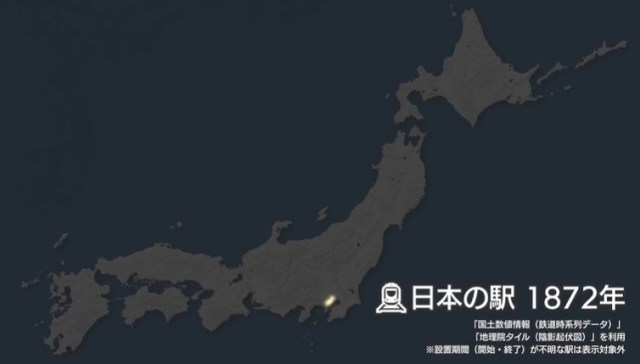
Points of light shine bright, and sometimes disappear, in this fascinating look at the last century and a half.
It’s hard to imagine Japan without trains. Whether it’s the Shinkansen zooming past Mt. Fuji or a Yamanote Line commuter train packed with office workers, railways are connected to some of the most iconic images of the country.
And yet, you don’t have to go all that far back, historically speaking, to get to a time when Japan didn’t have any trains at all. It was in 1872 that the very first train line opened in Japan, when Tokyo’s Shimbashi Station was connected what is now Sakuragicho Station in Yokohama, meaning that there’s been a rapid rail-ification of Japan in the time since, and to illustrate how it happened, Japanese Twitter user @ShinagawaJP has created a fascinating time-lapse-style video showing markers for every station in the country.
「駅」の移り変わりを動画にしてみた。鉄道開業から150年、時代とともに鉄道の役割、顔つきが変わっていくのが興味深い。タイムマシンでこの地図の続きを見てみたい。(・ㅅ・)#30DayMapChallenge Day 1: Points - Railway Stations in Japan pic.twitter.com/hgaGYrLgcg
— にゃんこそばデータ可視化 (@ShinagawaJP) November 2, 2022
With each station represented by a point of light, Japan starts with just two. It’s not long before more appear, though, with the area around Osaka and western Hokkaido being the next illuminated.
▼ 1882
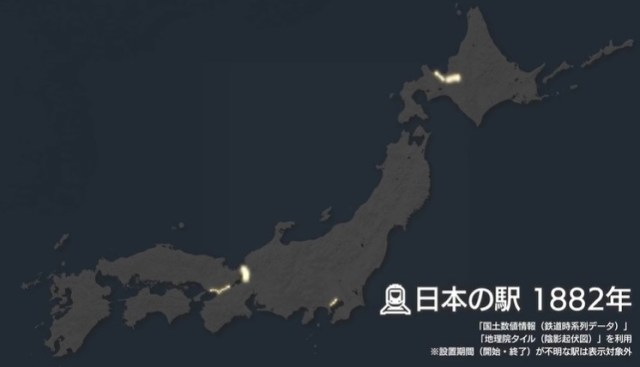
The pace really picks up after the Meiji restoration in 1888, when Japan ended centuries of feudal rule by the shogunate and modernization could take place. A year later, Tokyo and other Kanto region cities are connected with Kyoto, Osaka, and the other major communities of Kansai. Before the turn of the century, Western Japan’s Chugoku region and the Hokuriku area, on the north side of Japan’s main island of Honshu, get their first stations, as do the islands of Shikoku and Kyushu.
▼ 1895
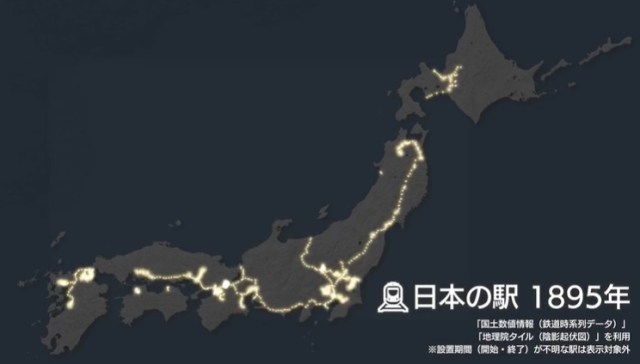
In 1925, pretty much the entire country is outlined in stations, and the area in between starts getting more and more filled in, and the concentration of stations seems to hit its peak in the 1960s.
▼ 1925
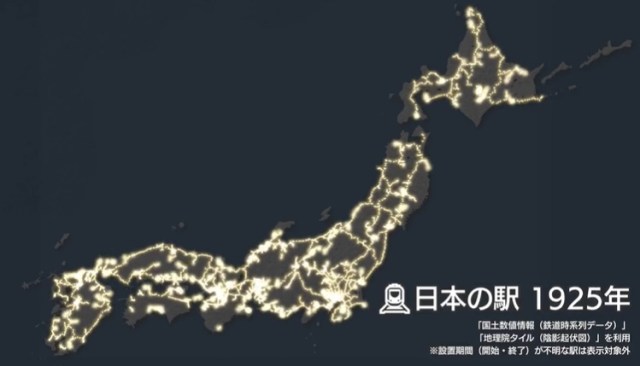
▼ 1960
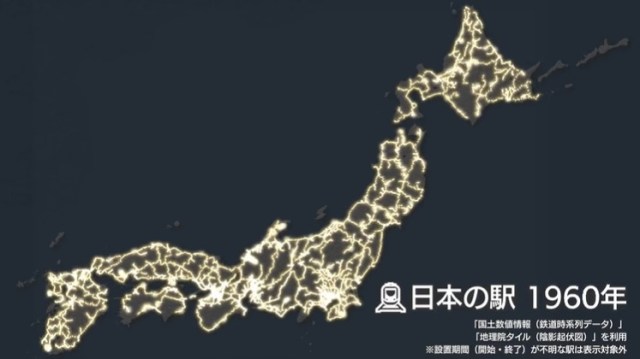
While the areas around Japan’s largest cities maintain their station density, in some other regions you can see lights going out as stations end their rail service. The phenomenon is especially noticeable in Hokkaido, @ShinagawaJP explains, as coal mines began shutting and as people moved away from the most remote, mountainous parts of the prefecture. Increases in personal car ownership as Japan enjoyed an economic boom in the 1960s, ‘70s, and ‘80s likely played a part too, as Hokkaido’s size and low population density make it a part of Japan where driving is often more convenient than taking the train.
▼ Time-lapse for Hokkaido
北から南へ眺めてみる。
— にゃんこそば
北海道の鉄道は栄枯盛衰。炭鉱が去り、中山間地域では人口減少が加速。生活インフラから地域のコミュニティまで、まさに"都市をたたむ"時代を迎えている。
※饗庭 伸 氏『都市をたたむ』・・・閉鎖(shut down)ではなく縮小(fold up)の意味 pic.twitter.com/GOXIkLza53データ可視化 (@ShinagawaJP) November 2, 2022
In the video focused on west Japan, we can see Kyushu go through a Hokkaido-like contraction, once again, @ShinagawaJP says, as a result of mining shutdowns.
九州では明治期から石炭鉱業が盛んで、水運などを置き換える形で鉄道が発達。
— にゃんこそば
その多くはエネルギー転換とともに使命を終えたが、うまいこと通勤列車にジョブチェンジした路線も。
地図では分かりにくいですが、路面電車が多いのも西日本の特徴。久々に長崎・思案橋をぶらついてみたい。(・ㅅ・) pic.twitter.com/6ZFE0suoklデータ可視化 (@ShinagawaJP) November 2, 2022
In Tohoku, trains first looped along the seashore before connections to the more mountainous interior sprouted.
こちらは東北地方。
— にゃんこそば
大動脈(東北本線など)から静脈(各都市を結ぶ中小路線)が生えていく様子が面白い。
※元データ(国土数値情報)には抜け漏れ・誤りがあります。全体的な変化を楽しんでいただければ。 pic.twitter.com/X0baomciG5データ可視化 (@ShinagawaJP) November 2, 2022
And last, the Kanto-to-Kansai span is where you’ll find the most populous cities in Japan, and so the areas around Tokyo, Nagoya, and Osaka all just get brighter and brighter.
煌々と輝く関東~関西。
— にゃんこそば
ただ、よく見ると”血行”の悪い盲腸線が淘汰されているのが分かる。駅の間引きもちらほら。
大量輸送と新幹線連絡、そのどちらも満たせないローカル線はこの先生きのこれるか。 pic.twitter.com/50cR9xBJpxデータ可視化 (@ShinagawaJP) November 2, 2022
“I wish I had a time machine so I could see what’s coming next for these maps,” @ShinagawaJP says. We’ll just have to wait and see, but at least while we wait for the next 150 years of train history in Japan we can search for those 150 hidden train station Pokémon.
Source: Twitter/@ShinagawaJP via IT Media
Images: Twitter/@ShinagawaJP
● Want to hear about SoraNews24’s latest articles as soon as they’re published? Follow us on Facebook and Twitter!
Credit:




0 comments: